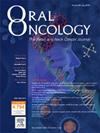Regional disease control in nasal vestibule squamous cell carcinoma: Systematic review and meta-analysis
IF 4
2区 医学
Q1 DENTISTRY, ORAL SURGERY & MEDICINE
引用次数: 0
Abstract
Objectives
To systematically analyze the regional disease control of nasal vestibule squamous cell carcinoma (NVSCC) after primary treatment.
Methods
The study was performed according to the PRISMA guidelines, searching on Scopus, PubMed/MEDLINE, Cochrane Library, and Google Scholar databases.
Results
A total of 37 studies with 1861 patients (70.5 % males; median age of 58.2 years) were included. Overall, the cumulative regional recurrence (RR) rate was 10.7 % (95 %CI: 8.4 %–13.5 %) with a median follow-up of 51.7 months. The RR rate in clinical node negative patients who didn’t undergo any elective neck treatment was 13.7 % (n = 548, 95 %CI: 9.7 %–19.0 %). When stratified by T stage, regardless of the classification used, RR rate was 10.4 % (n = 750, 95 % CI: 7.9 %–13.5 %) for T1-T2 tumors and 25.5 % (n = 102, 95 % CI: 16.4 %–37.4 %) for T3-T4 tumors.
Conclusion
Elective neck treatment does not seem justified in patients with early-stage primary NVSCC. However, for locally advanced tumors, elective neck treatment should be strongly considered.
方法 根据 PRISMA 指南,在 Scopus、PubMed/MEDLINE、Cochrane Library 和 Google Scholar 数据库中进行检索。结果 共纳入 37 项研究,1861 名患者(70.5% 为男性;中位年龄 58.2 岁)。总体而言,累积区域复发率(RR)为 10.7%(95%CI:8.4%-13.5%),中位随访时间为 51.7 个月。临床结节阴性且未接受任何颈部选择性治疗的患者的RR率为13.7%(n = 548,95 %CI:9.7%-19.0%)。如果按 T 分期进行分层,无论采用哪种分类,T1-T2 期肿瘤的 RR 率为 10.4 %(n = 750,95 % CI:7.9 %-13.5 %),T3-T4 期肿瘤的 RR 率为 25.5 %(n = 102,95 % CI:16.4 %-37.4 %)。结论对于早期原发性 NVSCC 患者来说,选择颈部治疗似乎并不合理,但对于局部晚期肿瘤患者来说,则应强烈考虑选择颈部治疗。
本文章由计算机程序翻译,如有差异,请以英文原文为准。
求助全文
约1分钟内获得全文
求助全文
来源期刊

Oral oncology
医学-牙科与口腔外科
CiteScore
8.70
自引率
10.40%
发文量
505
审稿时长
20 days
期刊介绍:
Oral Oncology is an international interdisciplinary journal which publishes high quality original research, clinical trials and review articles, editorials, and commentaries relating to the etiopathogenesis, epidemiology, prevention, clinical features, diagnosis, treatment and management of patients with neoplasms in the head and neck.
Oral Oncology is of interest to head and neck surgeons, radiation and medical oncologists, maxillo-facial surgeons, oto-rhino-laryngologists, plastic surgeons, pathologists, scientists, oral medical specialists, special care dentists, dental care professionals, general dental practitioners, public health physicians, palliative care physicians, nurses, radiologists, radiographers, dieticians, occupational therapists, speech and language therapists, nutritionists, clinical and health psychologists and counselors, professionals in end of life care, as well as others interested in these fields.
 求助内容:
求助内容: 应助结果提醒方式:
应助结果提醒方式:


